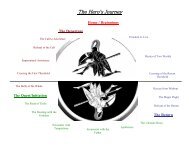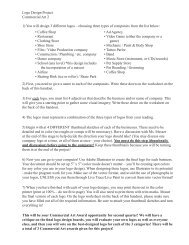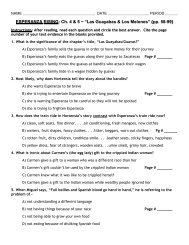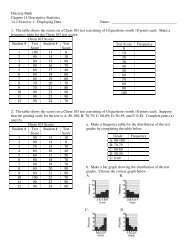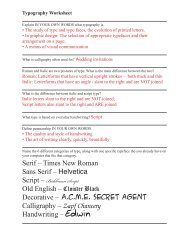World War One
World War One
World War One
- No tags were found...
Create successful ePaper yourself
Turn your PDF publications into a flip-book with our unique Google optimized e-Paper software.
The result of this war was psychological trauma-- a deep scar on European psyche. The romance of war had died. <strong>War</strong> was terror,horror–a futile orgy of mud and blood which resolved nothing. The rules of warfare had changed. New, terrible weapons of massdestruction, and the bombardment of civilians, created a more destructive vision of the future. Armageddon-like future visions nowterrified Europeans. People wrote about cataclysmic events for western society--a descent into brutality and insanity. People lost faithin their pre-war values, institutions, and philosophies. Now all they had left was pessimism and insecurity, which caused massivepolitical, social, and economic upheavals, a deep scar on European psyche.“The horrors of the trench—rotting horseflesh, mud, poor food, weapons that would not fire, poison gas, and the sheer terror ofwaiting for death—the Great <strong>War</strong> was a big lie. There was no tangible enemy. The insanity of it all!”“We see men living with their skulls blown open; we see soldiers run with their two feet cut off…still the little piece ofconvulsed earth in which we lie is held. We have yielded no more than a few hundred yards of it as a prize to the enemy. <strong>One</strong>very yard lies a dead man.”Total <strong>War</strong>Wilson said, “Those who remain to till the soil and man the factories are no less apart of the army as the men beneath the battle flags.”Everyone felt the strain at home-- Allies and Central Powers suffered shortages offood, ration books, limited amounts of gas, bacon, sugar, and paper. There weremeatless Mondays and wheatless Wednesdays. Germany saved all of its precious white flour for the troops and had only dark(pumpernickel) bread for civilians. This dark bread was called victory bread throughout Europe. Austria-Hungary had no more pigs (forpork) and by the end of the war the civilians were suffering from starvation.There was a labor shortage, and family life was altered as the men (18-40) had gone to a war of attrition. If these men came back at all,they came back physically injured or emotionally damaged (shell shocked). Conscription (the draft) had put a uniform on every ablebodiedman. Great Britain started with volunteers (1 million between 1914-1915) but they were forced to resort to conscription. Theyneeded to keep skilled workers in the factories (making munitions), so thousands of laborers were shipped in from the colonies (India,China, Africa) to work on farm and in heavy factory labor. The colonies thought if they performed well, they would get their freedomafter the war.6 million served from Great Britain (and her colonies). 750,000 men died, 1.7 million were wounded.Many were young and unmarried. 160,000 had wives who lost their husbands. 300,000 children lost fathers.During the war, women went to work and production soared. In Britain, 1,345,000 women were employed in jobs considered “beyondthe capacity of women,” such as chimney sweeps, truck drivers, farm labor, steel mills, streetcar driver’s, mail carriers, police officers,munitions plants, and factory workers for heavy industry. French women made 35,000 aircraft, 5000 tanks, and 300,000 artillery shellsper day. 38% of workers in the German Krupp armaments factories were women (1918). Many women served as nurses close to thefront lines (movie: The English Patient).Male workers were concerned that lower female wages would depress their own wages. Women might demand equal pay. Women’splace in the workforce was not secure. At the end of the war, governments removed women from the jobs they had encouraged themto take. When the war ended (1919) 650,000 women became unemployed in Great Britain and wages for women were lowered again.The role of women in the wartime economy had a positive impact on the women’s movement for social and political emancipation.Britain, Germany, and Austria gave women the right to vote by 1918. America was one of the last countries (1920). Upper middle-classwomen were now allowed to take some jobs, have their own apartments, and show independence by smoking in public, wearingshorter dresses and hair, and makeup. This will eventually lead to the flapper movement of the 1920s.27




